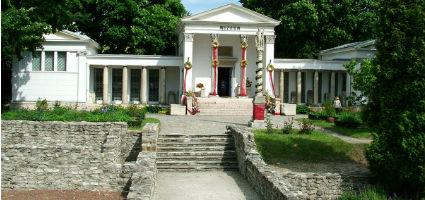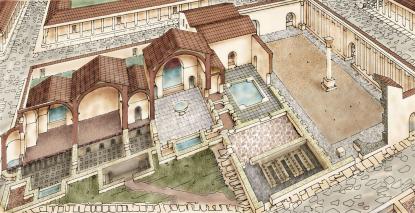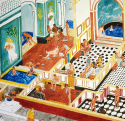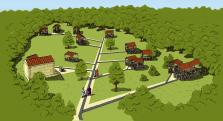2024. April 20. Saturday
Budapest History Museum - Aquincum Museum - Budapest
 |
Address: 1031, Budapest Szentendrei út 135-139.
Phone number: (1) 250-1650, (1) 430-1081
E-mail: aquincum@aquincum.hu
Opening hours: 01.04-31.10.: Tue-Sun 10-18
Park: 9-18 01.11-31.03.: Tue-Sun 10-16< |
The exhibition has closed for visitors.
Museum tickets, service costs:
|
Ticket for adults
(summer term)
|
1600 HUF
|
/ capita
|
|
Ticket for adults
(in winter)
|
1000 HUF
|
/ capita
|
|
Individual ticket for adults
|
1000 HUF
|
/ /capita
|
|
Group ticket for adults
(in winter)
|
1000 HUF
|
/ capita
|
|
Ticket for students
(summer term)
|
800 HUF
|
/ capita
|
|
Ticket for students
(in winter)
|
500 HUF
|
/ capita
|
|
Individual ticket for students
|
500 HUF
|
|
|
Ticket for pensioners
(summer term)
|
800 HUF
|
/ capita
|
|
Ticket for pensioners
(in winter)
|
500 HUF
|
/ capita
|
|
Individual ticket for pensioners
|
500 HUF
|
|
|
Ticket for families
(summer term)
|
2100 HUF
|
/ family
|
|
Ticket for families
(in winter)
|
1700 HUF
|
/ family
|
|
Program ticket
|
900 HUF
|
|
|
Program ticket
|
800 HUF
|
|
|
Season ticket for a year
|
8000 HUF
|
|
|
Season ticket for a year
|
30000 HUF
|
|
|
Season ticket for a year
|
20000 HUF
|
|
|
Season ticket for a year
|
160000 HUF
|
|
|
Season ticket for a year
|
160000 HUF
|
|
|
Individual season ticket for a year
|
5000 HUF
|
|
|
Group guide
(min. 20 capita)
|
1000 HUF
|
/ / capita
|
|
Group guide
(over 25 people)
|
8000 HUF
|
/ group
|
|
Group guide for adults
|
4000 HUF
|
/ group
|
|
Group guide for students
(in summer)
|
600 HUF
|
/ / capita
|
|
Group guide for students
(min. 10 capita)
|
450 HUF
|
/ / capita
|
|
Group guide for adults
|
6000 HUF
|
|
|
Photography
|
600 HUF
|
/ piece
|
|
Video
|
600 HUF
|
/ piece
|
The exhibition presents the bathing habits of the Romans, which were not only about the needs of daily hygiene, but also about ‘being well’ and ‘feeling good’. Baths were the place of recreation for both body and spirit. Although in Aquincum all that remained of this are some stones, bricks, mortar, metal- and ceramic fragments, but with the help of ancient eye-witnesses, all this gets filled with the clamorous life of old times.

We know of twenty-four baths from Aquincum. These were supplied with water, at least partly, from the springs of the modern-day Római Open-air Bath, through the North-South aqueduct. The catchment basins were discovered during excavations. In all well-houses, built around the catchment basins, stood altars dedicated to healing deities; and sacrificial gifts thrown into the springs have also been found there. The exhibition presents the relics of medical activity connected to the baths and of the uses of water from thermal springs.
Finds discovered in Aquincum and reconstruction drawings present the very thoughtful and logical operation of the typical Roman baths: the tripartite system – consisting of a cold-water bath, a warm room, and a highly humid hot-water room –, the floor heating and the connected heating of water, the water supply and sewage management. This architectural frame was filled with life by everyday real people, who used the baths. We can, of course, only imagine the noise, the hubbub, and racket, but everyday objects used at the baths have been found during excavations, and these are presented in the showcases.
Visitors to the exhibition can also find out about what we have inherited from the Romans. Please follow us to Aquincum’s baths, let us explore Roman wellness!
Sponsored by Budapest Waterworks

We know of twenty-four baths from Aquincum. These were supplied with water, at least partly, from the springs of the modern-day Római Open-air Bath, through the North-South aqueduct. The catchment basins were discovered during excavations. In all well-houses, built around the catchment basins, stood altars dedicated to healing deities; and sacrificial gifts thrown into the springs have also been found there. The exhibition presents the relics of medical activity connected to the baths and of the uses of water from thermal springs.
Finds discovered in Aquincum and reconstruction drawings present the very thoughtful and logical operation of the typical Roman baths: the tripartite system – consisting of a cold-water bath, a warm room, and a highly humid hot-water room –, the floor heating and the connected heating of water, the water supply and sewage management. This architectural frame was filled with life by everyday real people, who used the baths. We can, of course, only imagine the noise, the hubbub, and racket, but everyday objects used at the baths have been found during excavations, and these are presented in the showcases.
Visitors to the exhibition can also find out about what we have inherited from the Romans. Please follow us to Aquincum’s baths, let us explore Roman wellness!
Sponsored by Budapest Waterworks



